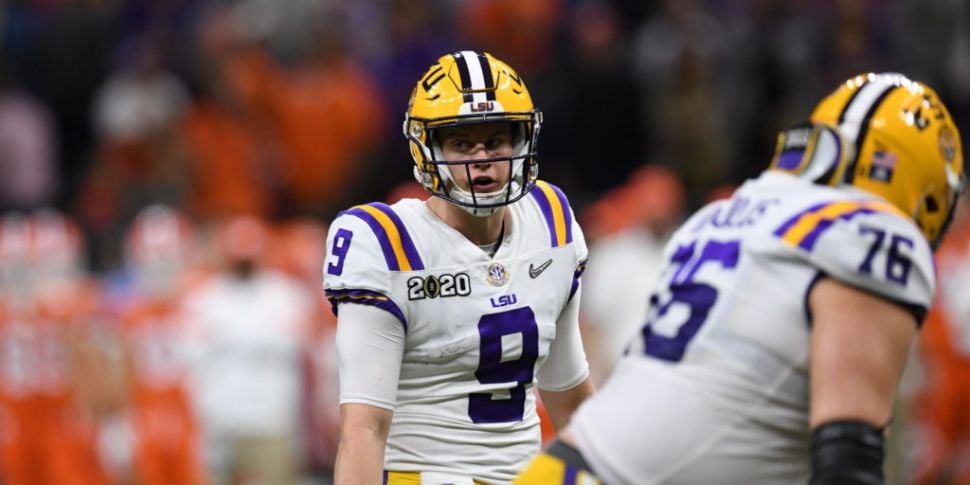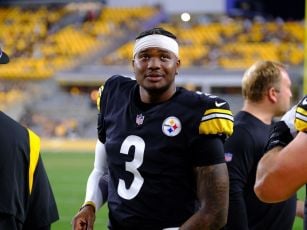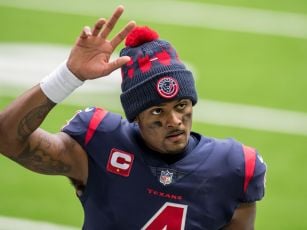Joe Burrow is the Cincinnati Bengals new starting quarterback. He'll replace Andy Dalton and try to lead the Bengals towards their first playoff win since 1990. That's unlikely to happen in 2020 but Burrow can establish himself as one of the best young quarterbacks in the NFL from the start of his rookie year.
Not every team in the NFL is trying to win the Super Bowl each year. Sure, they'd all like to if they could but each team is at a different stage of their development curve. Franchises in the depths of rebuilding don't get hot enough to reach February. The Cincinnati Bengals had the worst record in the NFL last year. They turned that into their new starting quarterback: Joe Burrow.
Burrow was the consensus top prospect in the 2020 NFL draft and one of the best prospects of the last 10 years. He's spectacular. He brings a broad skill set with peak traits that even the best quarterback prospects don't possess from year to year. But no rookie quarterback has ever won the Super Bowl. No rookie has even started in the Super Bowl.
Going from the worst team in the league to the best team in the league isn't a rational reality.
Instead, Bengals fans can ignore the W-L record in 2020 and focus solely on three elements of the franchise. Burrow, Jonah Williams and Zac Taylor. Those are the three figures that when interlocked together can make up the foundation from which the Bengals can build their future success.
Left tackles no longer carry the heightened importance that they once did. It used to be that defences put their best pass rusher on the quarterback's blindside, the left side of the offensive line. That forced the offence to put its best pass protector on the left side. Now NFL teams have exceptional pass rushers at every spot on their defensive lines. That means each offensive line position is equal in importance. It also means there's a premium on offensive line talent.
Jonah Williams was drafted 11th in 2019. He missed his rookie season through injury, meaning he'll make his first start for the Bengals this season. Williams has the talent to be as important as Andrew Whitworth. Like Whitworth, he is a good all-around athlete without being a spectacular athlete. His functional athleticism on the field was better than his testing athleticism in college. He won't dominate defensive ends with his power but his movement skills and technique will allow him to create leverage.
If Williams and Burrow both workout, they can start together for the next 15 years.
Zac Taylor is unlikely to last that long. It's easier for NFL teams to replace their head coaches if they fail than their starting quarterbacks. If Taylor does flameout, the Bengals can find someone else to nurture Burrow's development and design the offence around him.
Winning the Super Bowl this year isn't the goal for the Bengals. A strong rookie season from Burrow and Williams as well as a clear idea of who Taylor can be as a head coach moving forward is what matters most this year. It would set them up to take a massive step forward in 2021 as they continue their rebuild. And it's important to note that a good first season for Burrow doesn't mean he has to have comparable success to Lamar Jackson or Patrick Mahomes right away.
He doesn't need to drag his team to the playoffs like Andrew Luck or reset Baker Mayfield's touchdown record either. A good rookie season from Burrow will be measured on how his traits translate to the NFL.
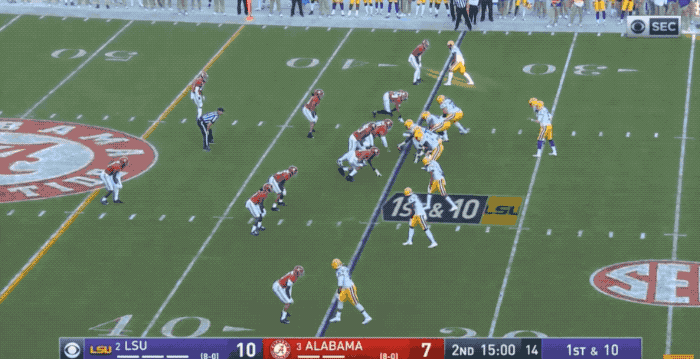
No matter how good a quarterback looks in college, you still never really know how well he'll play in the NFL until he actually does so. The biggest challenge that Burrow will face in the NFL is how he manages an NFL pocket. While Jonah Williams is an exciting prospect at left tackle, the rest of the Bengals offensive line looks leaky. That will be a stark contrast to the game Burrow played in college.
The LSU offensive line, particularly the interior, was outstanding. Burrow regularly had space and time in the pocket. He could step into most of his throws and didn't need to function in condensed pockets. That didn't mean his job was always easy but it does mean he wasn't exposed to situations he'll see on Sundays.
Against Alabama, the LSU offensive line repeatedly stonewalled the talented pass rushers even when isolated one-on-one.
The above play moves at half speed. Only Burrow's right tackle concedes any ground. He loses off the snap but recovers well to re-engage the edge rusher when Burrow steps up. Burrow's eyes ae in the middle of the field but he feels the pressure. His reaction is good to step forward into the pocket then deliver the ball accurately to his running back. His running back turns the good service into a first down after the catch.
Burrow had space to step up into despite Alabama blitzing. His interior linemen all stopped their assigned pass rushers at the moment they contacted them. That's rare for most offensive linemen. It was standard for this offensive line.

On this play from the same game, the defensive end at the top of the screen gets a great jump at the snap. He draws a double team initially and is stopped. The only defender inside of him who creates any penetration falls over as he does. All of the other blitzers are stopped. Burrow shows discipline to keep his eyes downfield and locate his wide-open receiver for the touchdown.
That's not a difficult play. It's a play any college quarterback can make. But an NFL quarterback makes that play 99 times out of 100. College quarterbacks are more likely to drop their eyes and run or not see the open option. Burrow's brilliance in the pocket was about his consistency doing the right thing. He maximized the output of his receivers by taking advantage of his good pass protection.
Tony Romo used to be the most patient passer in the NFL. What this meant was he was willing to hold the ball in a clean pocket for as long as the pocket stayed intact and for as long as his receivers needed to come open. He rarely panicked just because there wasn't an obvious outlet.
Unlike Romo, Burrow has the athletic profile to be a scrambler in the NFL. That's a temptation he'll have to resist because he also has the capability to be one of the most patient passers in the league, a more valuable trait.
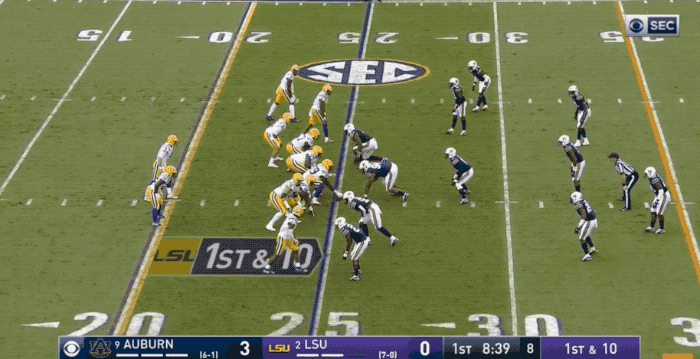
As a rookie playing behind a leaky offensive line, Burrow's processing won't be especially quick and he'll be under excess pressure. That's where scrambling will help him avoid making critical mistakes and taking sacks. Finding the right balance in your process to feel pressure and adjust your timing is a critical aspect of sustaining success as an NFL quarterback. Burow's consistency in college came because he had that perfect balance.
On this play, Auburn attempt to confuse him by using a three-man defensive line with the fourth rusher coming from the second-level. This forces Burrow to have a hot read even though the defence isn't blitzing.
Burrow's eyes begin on the left side of the play. He sees the blitzer coming and changes his body shape. He makes one subtle step to his right to change the angle for the pass rusher and buy himself one extra moment to release the ball. His pass arrives at his running back just before the defender for a short gain. This is the type of unseen important play because even though the offence only gained three yards, the quarterback avoided a sack and didn't heave the ball into coverage on the front side of the play.

Against Georgia in the SEC Championship Game, the defence successfully blitzed Burrow on Second-and-8. The offence was behind the down-and-distance so the defence could get creative with their play call. They got a blitzer through clean. Burrow had to react quickly and he did, finding his hot route for the first down throw.
Burrow threw seven touchdowns in that game. This play actually came after his first touchdown, a play that existed at the exact opposite end of the spectrum.
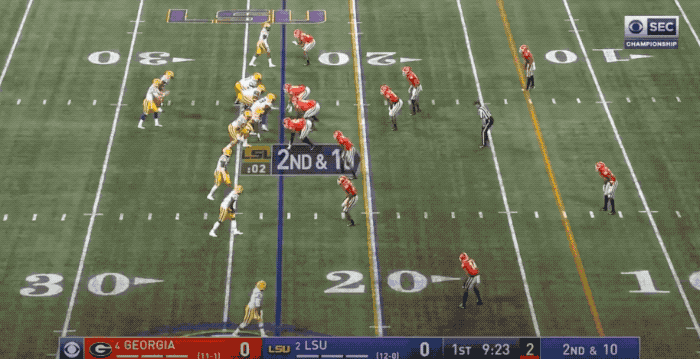
There's a composure in Burrow's play that isn't typical of college passers. He sets and resets his feet in the pocket while feeling the pressure so his eyes can stay downfield processing the coverage. For his first touchdown, the defence used a three-man rush. Three-man rushes are the opposite of blitzes. Recognizing when the defence calls them is critical. You have to hold the ball and move within the pocket to force the defenders to cover for longer and adjust to the everchanging point of attack.
Eventually, an opening is created and Burrow can hit it because he was always in position to survey the field/throw the ball.
While this is a positive play for Burrow's process in the pocket, it's also representative of Burrow's general ball placement. It's not a perfectly thrown pass. J'Marr Chase, the best player in this offence and likely the best player in college football, is forced to work back through the defender instead of continuing across the back of the endzone. He bullies the defensive back out of the way and catches the ball into his chest.
It's easy to confuse a great play by a receiver with a perfectly thrown ball. Burrow's receivers were outstanding across the board. Burrow himself is very consistent with his ball placement but he doesn't have the superstar level precision throwing into tight windows that his college success suggests.
Burrow has the type of ball placement that will get the most out of a good receiving corps but won't elevate bad receivers. His ball placement is less important because of how well he processes defences. He's more likely to find the open receiver on each play than his peers.
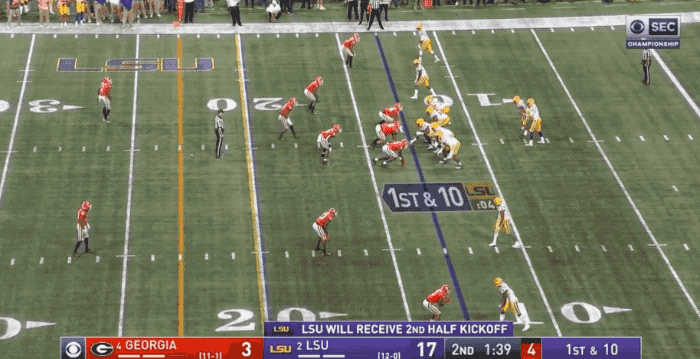
Sticking with the Georgia game, this is a prime example of Burrow working the defence to locate the easiest throw. The defence again tries a three-man rush, abandoning any attempt to win with a four-man rush. Burrow recognizes it and uses the time o read the front side of the play (the right side), then come all the way back to the backside (the left side) before reverting his eyes to the middle of the field.
In the middle of the field, his running back has come wide open for the huge gain. Ball placement isn't a big factor in this play because it doesn't need to be.
Note the pump fake Burrow used to pull the linebackers to the front side of the play before he turned back to the opposite side. That helped to create space for the running back to get open. Also, note the timing of the ball coming out relative to the pass rusher getting home. He maximized the time he had in the pocket before releasing the ball, allowing his receivers' routes to develop and pull the defenders further downfield.
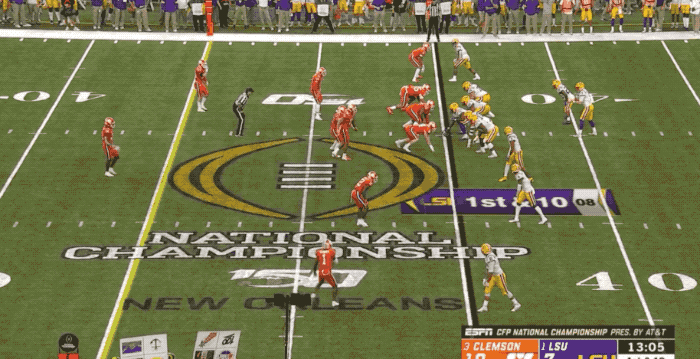
When he wants to, Burrow can hasten his throwing motion to speed up his release. That allows him to hit tighter windows on short throws with perfect timing. He adjusts his ball trajectory and placement depending on the situation that develops in front of him. His consistency to each level of the field is startlingly impressive and his arm is strong enough to make any throw.

There is no effort for Burrow pushing the ball deep. He's an outstanding vertical passer. He can arch ball over trailing defenders while sustaining velocity from start to finish. When throwing deep, it's important to get the right depth but it's also important to lay the ball on the right line. Placing the ball just inside the sideline every time is a talent that Russell Wilson shows off regularly. Burrow has it too.
When the defence rotates down to blitz on this play, Burrow knows he has one-on-one coverage with J'Marr Chase. The receiver lined up in the slot and beat A.J. Terrell with relative ease. Burrow's ball drops perfectly over his shoulder.
There isn't anything on the football field that Burrow can't do.
Importantly for A.J. Green, if the receiver stays in Cincinnati, Burrow is also aggressive throwing into tight windows. He seeks out big gains and understands when he has a matchup advantage to take advantage of. It's important to understand that Burrow is aggressive, not reckless. When he seeks out matchups, he throws the ball to spots of leverage that favour his receiver. So even if he's throwing into a tight window, he's not putting the ball at risk and he's not just throwing it up for grabs aimlessly.
So long as the Bengals give him a competent supporting cast, he should quickly develop into an effective starter. The question then becomes can he advance to become one of the best quarterbacks in the NFL. Whether that happens or not nobody can know at this point.
What we do know is that Burow has a clear and considered process. Everything he does has a purpose. When you watch him perform, you can see why he does what he does at each stage of each play. His process is like that of Patrick Mahomes, Dak Prescott or Lamar Jackson rather than a Kirk Cousins, Baker Mayfield or Josh Allen. He's already got the most difficult aspects of the position down.
Read Off The Ball's quarterback breakdowns:
Aaron Rodgers is still an elite quarterback.
Baker Mayfield will be a liability again in 2020.
Ryan Tannehill's success is unsustainable.
Deshaun Watson is on the precipice of greatness.
Drew Lock is worthy of his hype.
Jared Goff is still trying to figure it out.
Steelers missed opportunity with Ben Roethlisberger.
New England Patriots, Cam Newton perfect for each other.
Download the brand new OffTheBall App in the Play Store & App Store right now! We've got you covered!
Subscribe to OffTheBall's YouTube channel for more videos, like us on Facebook or follow us on Twitter for the latest sporting news and content.

